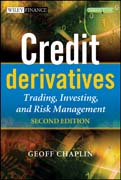
The credit derivatives industry has come under close scrutiny over the past 2years, with the Credit Crisis highlighting the instability of a number of credit structures and throwing the industry into turmoil. What has been made clear by recent events is the necessity for a thorough understanding of credit derivatives by all parties involved in a transaction, from traders, structurers, quants and investors. This book covers the subject from a real world perspective, tackling issues such as liquidity, poor data, and credit spreads, to the latest innovations in portfolio products, hedging and risk management techniques. The book concentrates on practical issues and develops an understanding of the products through applications and detailed analysis of the risks and alternative means of trading. Credit Derivatives: Risk Management, Trading and Investing provides: A description of the key products, applications, and an analysis of typical trades including basis trading, hedging, and credit structuring Analysis of the industry standard 'default and recovery' and Copula models including many examples, and a description of the models' shortcomings Tools and techniques for the management of a portfolio or book of credit risks includingappropriate and inappropriate methods of correlation risk management A thorough analysis of counterparty risk An intuitive understanding of credit correlation in reality and in the Copula model The book has been thoroughly updated toreflect the changes the industry has seen over the past 5 years, notably withan analysis of the lead up and causes of the credit crisis. It will contain 50% new material, which will include copula valuation and hedging, portfolio optimisation, portfolio products and correlation risk management, pricing in illiquid environments, chapters on the evolution of credit management systems, the credit meltdown and the mathematics of the credit bubble. The book is accompanied by a CD ROM which will illustrate the models used in the book and also provide an advanced valuation toolkit. Contents [Foreword] Preface Disclaimer Acknowledgements Part I: Credit Background and Credit Derivatives 1. Credit Debt and other traditional credit instruments 2. Pricing Methods 3. Default Transition Matrices; Historical Pricing 4.The Credit Event for Debt 5. Asset Swaps and Asset Swap Spread; z-spread 6. Liquidity 7. Credit portfolios and portfolio risk Software examples: Transition matrix based pricing; historical and implied transition matrices Asset swap, z-spread, maturity spread calculations Portfolio correlation and VaR Part II: Credit Default Swaps and other Single NameProducts 8. Credit Default Swaps: Product Description, and Simple Applications - 9. Valuation and Risk: Basic Concepts - 10. CDS Deal Examples 11. CDS/BondBasis Trading 12. Sensitivities; Hedging Issues 13. Credit Linked Notes 14. Digital CDS 15. Basket CDS and Index CDS structures 16. Spread Options, Callable/Putable Bonds, Callable Asset Swaps, Callable Default Swaps 17. Total ReturnSwaps 18. Single Name Book management 19. CDS Pricing by Simulation Software examples: Deterministic model [Excel and MathCad] Debt valuation [Excel and MathCad] CDS valuation [Excel and MathCad] Sensitivity calculation examples [Excel and MathCad] Part III: Portfolio Products - Correlated stochastic recovery models, Semi-closed form solutions, Structure pricing Correlation in structures. CDOs and structured credit products - synthetic - static and standard indexproducts - synthetic - bespoke, static and managed - cashflow CDOs - securitisations - rating (update), SPV, applications - product risks (bubble related to enhanced sales opportunities) - pricing at 0 and 100% correl - other portfolio products (contributed) Copula valuation and hedging (method) Correlation - in the real world and further section on correlation in normal and abnormal environments - e.g. correlation of life policy values. - matrix and tag - factor/tranche/compound - base - correlated stochastic recovery - Monte Carlo pricing - Semi closed form pricing Application of Copula valuation - Synthetics: 21.6 to 21.8 rewritten - Cashflow CDO - Structures Portfolio Optimisation (contributed) Other Copulae Portfolio Products and Correlation Risk management Pricing methodologies in illiquid environments Part IV: Default Swaps including Counterparty Risk - CDS as a portfolio product Vanilla CDS Counterparty (‘Double trigger’) CDS Part V:- NEW The Evolution of Credit Management Systems The Credit Meltdown and rebirth of CDS The Mathematics of the Bubble Mathematical Appendix: List of Abbreviations Glossary References IndexGeoff Chaplin (Tokyo, Japan) is a partner at Reoch Credit Partners and also aDirector of a Credit Derivatives software company. He studied mathematics at Cambridge (MA 1972) and Oxford (MSc 1973, DPhil 1975) and, after a year's postdoctoral research, he trained as an actuary (FFA 1978) while working in a lifeinsurance company. From 1980 he worked in the City, primarily in fixed incomebonds and derivatives, in a trading or quantitative role. From 1988 to 1994 he was an independent consultant advising hedge funds, corporate treasurers, and institutional investment funds, then joined HSBC where he ran European government fixed income strategic investment. Since 1996 he has been trading and developing risk management infrastructure for credit derivatives, initially at Nomura International, then for four years at ABN AMRO Bank NV, where he set up the credit derivatives risk management system and traded exotic credit derivatives. Geoff briefly moved to SunGard where he built credit derivatives systems, performed independent valuation of CD products, and ran CD training courses.Recently he has returned to independent consulting. Geoff has maintained strong academic interests - he was a visiting (emeritus) professor at the University of Waterloo (Canada) from 1987 until 1999. He has also published many articles (in Risk, the Journal of the Institute and Faculty of Actuaries, and many others) and speaks regularly at conferences on credit derivatives.
- ISBN: 978-0-470-68644-7
- Editorial: John Wiley & Sons
- Encuadernacion: Cartoné
- Páginas: 408
- Fecha Publicación: 05/03/2010
- Nº Volúmenes: 1
- Idioma: Inglés
